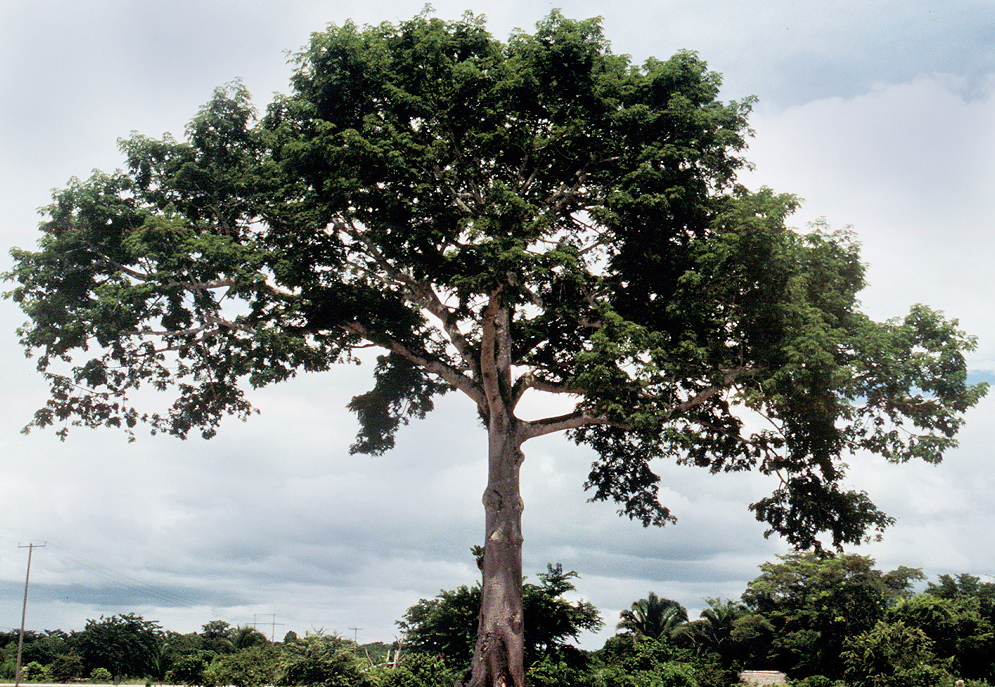Chris Martin (cm194106)
Plant Ecology PBIO 209
Winter 08
Dr. Kim Brown
Kapok, Ceiba, and Silk-Cotton Tree
Ceiba pentandra
Malvaceae
The Ceiba caught my interest while studying abroad in Costa Rica and Belize. To me it seemed to be the king of the tropical plant kingdom. The mighty tree stands over the surrounding forest like a watchtower. From a distance one can only imagine the amount of life and activity taking place in its canopy; holding a micro-world in the arms of its branches. To some organism the Ceiba they occupy may be their entire home range.
The C. pentandra’s native range is from Mexico to the bottom of South America and Caribbean, but does not extend into the Brazilian lowlands (Kapok Tree 2006). Humans have introduced it through out West Africa and Southeast Asia. The Kapok’s native and introduced range is shown in figure 1 (Range map image 2008).
It’s a rainforest canopy tree that can grow upwards of 150 ft (Kapok 2008). The tree has a long strait trunk that supports its wide branching crown (Kapok 2008). The Ceiba is often used as a landmark or reference point in the forest because it towers over the surrounding canopy (Horwich 1998). Figure 2 shows a classic growth pattern of the Ceiba. The bark though smooth has large defensive spines. Figure 3 shows the wide buttress base that supports this massive tree (Ceiba pentandra 2008). The Ceiba is a perennial deciduous tree shedding its leaves during the dry season. It flowers generally before the leaves bud again; the white-pink flowers are primarily bat pollinated. The seedpods open up to release fibrous cotton like seeds, which are distributed by wind. (Kapok Tree 2006)
The Ceiba supports its own eco-system of flora fauna. The large branches stem horizontally from the trunk, and support an array of nesting birds, bats, epiphytes, amphibians, and mammals (Kapok Tree 2006). The Ceiba is also significant to Mayan culture, as believed to be bridge from the underworld to the heavens (Horwich). Dug out canoes are a traditional use of the long strait trunk (blue). The fiber from the seed pod can be used for pillows, mattress’s, and insulation (Kapok 2006)(Kapok 2008).
The biomes the Ceiba inhabits ranges mainly from Tropical & Sub Tropical Moist Broadleaf to Tropical & Sub Tropical Dry Broadleaf Forest, but also is found in Tropical
& Sub Tropical Savannas. According to Kricher tropical forest cover about 7% of the earths surface while containing about 50% of the biodiversity (Kricher 1997). The most significant difference between tropical & sub tropical moist and dry forest is the variation between wet and dry seasons (Kricher 1997). The Ceiba’s phenology tunes into to this wet and dry pattern. The tropical forest are characterized by a consistent twelve hour light patterns and heavy rainfall (Kricher 1997). These conditions are ideal for agriculture production. However, the vast majority of the soil is very nutrient poor; all nutrients are quickly absorbed and stored by vegetation. Large-scale monoculture production is only possible with the addition of synthetic fertilizer or slash-and-burn techniques to release stored nutrients from forest biomass. Large scale mechanized modern agriculture is a leading reason for deforestation, loss of biodiversity, and many other socio-economic problems in the tropics (Kricher 2007). Small landholding where peasant farmers manage farms intensively and using sustainable methods would reduce the need to destroy vast swathes of tropical forest. Unfortunately due to the economic status and dependence of foreign inventers most Latin American counties, a massive land reform is out of the realm of possibility.

Figure 1: Global distribution of Ceiba pentandra (Range map image 2008)

Figure 2: Ceiba growth pattern (Ethnobotany & Florist of Belize 2

Figure 3: Buttress Roots (Ceiba Pentandra 2008)
Works Cited:
• Kricher, John. 1997. A Neotropical Companion. Princeton (NJ): Princeton University Press. p.3-12,334-361
• Horwich R, Lyon J. 1998. A Belizean Rainforest. Grey Mills (WI): Orang-utan Press. p.
• Kapok Tree [Internet]. [updated 2006 Nov 7]. Blue Planet Biomes. [Cited 2008 Feb 19] Available from: www.blueplanetbiomes.org/kapok.htm
• Kapok [Internet]. [updated 2008 Feb 13]. Wikipedia Foundatin Inc. [cited 2008 Feb 19] Available: http://en.wikipedia.org/wiki/Kapok
• Range Map Image [Internet]. [updated 2008]. Seattle (WA). Woodland Park Zoo. [cited 2008 Feb 19]. Available: http://www.zoo.org/factsheets/ceiba_tree/rg_map_world.html
• Ethnobotany & Florist of Belize [Internet]. [updated 2007]. Bronx (NY). New York Botanical Garden [cited 2008 Mar 4]. Available: http://www.nybg.org/bsci/belize/gallery.html
• Ceiba Pentandra [Internet[. [updated 2008]. Dade Co. (FL). Plant systematics .org [cited Mar 4]. Available: http://www.plantsystematics.org/cgi-bin/dol/dol_terminal.pl?taxon_name=Ceiba_pentandra
Comments (0)
You don't have permission to comment on this page.